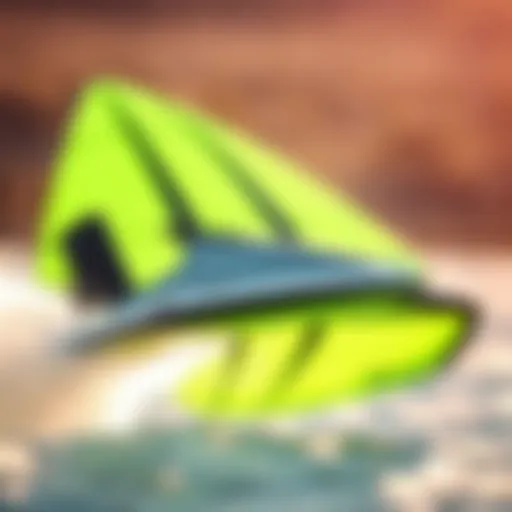Exploring Small Kites in Kiteboarding


Intro
Kiteboarding enthusiasts often find themselves captivated by the artistry and mechanics behind the kites they wield. This exploration of small kites reveals how they fit into the larger kiteboarding experience. Understanding their construction, performance, and appeal helps both newcomers and seasoned riders make informed choices.
Within this vibrant world of small kites, lies a treasure trove of factors that contribute to their rise in popularity. Whether riding the waves or carving through the skies, small kites offer unique advantages. They can be nimble, agile, and perfect for various conditions, making them favored among kiteboarders. Let’s delve deeper into the intricate landscape surrounding small kites.
Gear Insights
Latest Gear Reviews
The marketplace is flooded with a wide range of small kites, and choosing the right one can feel like finding a needle in a haystack. Many brands have put their best foot forward to combine performance with adventure. For instance, the Slingshot B2 is renowned for its ability to perform well in light winds, making it a prized pick among riders in coastal regions. Its construction embodies both strength and flexibility that kiteboarders crave.
In contrast, Naish Boxer kites boast reliability and consistent performance across varying wind conditions. These kites' construction utilizes durable materials which stands up to the wear and tear of frequent use, thereby ensuring they maintain their performance over time.
"Choosing the right kite is just as crucial as knowing how to ride it. A mismatch can lead to a challenging experience."
Essential Gear for Beginners
For beginners venturing into the realm of kiteboarding, understanding the essential gear is critical. Here’s a rundown:
- Kite: Starting with a medium-sized kite, such as the Ozone Edge, can provide a good balance of control and power.
- Board: It’s wise to choose a larger board, which helps with stability on the water.
- Harness: A comfortable harness can make a world of difference, especially for longer rides.
- Safety Gear: Don’t skimp on safety—helmets and impact vests can save you from accidents.
These components lay the groundwork for a solid kiteboarding adventure.
Techniques and Tips
Advanced Tricks and Techniques
Once you've gotten your bearings, advancing to more challenging tricks becomes a goal. For example, mastering the backroll can elevate your gameplay from mundane to extraordinary. Start by practicing this move on flat water before taking it to the waves.
A step-by-step approach usually involves:
- Building speed by edging hard upwind.
- Popping off the water by bending your knees and jumping when you feel the pull.
- Tucking your knees while rotating, allowing your kite to control the flight.
Safety Practices for Kiteboarders
Kiteboarding comes with risks no matter how experienced you are. Adhering to safety practices is paramount. Always check your equipment before gearing up; even a minor flaw can result in unwarranted accidents.
It’s also prudent to keep your distance from others while on the water. Maintaining a safe zone not only protects you but others riding as well. Joining kiteboarding communities online can be beneficial. For discussions and tips, platforms like reddit.com provide robust forums connecting riders across the globe.
By grasping these fundamentals, one can truly enjoy the thrill and freedom that kiteboarding with small kites offers.
Understanding Small Kites
When exploring the essentials of kiteboarding, grasping the nature of small kites becomes crucial. This section will look into what small kites bring to the table, their unique attributes, and why they’re gaining traction among both beginners and seasoned enthusiasts alike. Recognizing their operational dynamics can lead to more informed choices, potentially elevating your kiteboarding experience.
Definition and Characteristics
Small kites refer to those that typically range from about 1.5 to 5 meters in size. They are designed for various conditions and types of kiteboarding, thus adapting to the rider's skill set and wind patterns. Unlike larger kites, small kites tend to be lighter, more manageable, and are often preferred for technical riding and tricks. They are built with a common set of characteristics that not only enhance agility but also improve responsiveness.
Typical characteristics include:
- Lightweight Materials: Fabric like ripstop nylon is popular among manufacturers, offering durability without added weight.
- Superior Maneuverability: Small kites are excellent for quick turns and tricks, appealing to those who revel in a dynamic kiteboarding style.
- Compact Design: They can be easily packed, making them a fantastic option for travelers who often chase the wind.
Understanding these features can help kiteboarders decide whether small kites suit their riding style and conditions. Moreover, their design allows for optimal wind range adaptation, giving riders an edge in varying weather scenarios.
Historical Context
The development of small kites has roots in both traditional and modern forms of kite-related activities. Historically, the concept of using kites for more than just leisure can be traced back centuries, from military applications to agricultural purposes. However, it wasn't until the late 20th century that small kites began being tailored specifically for sport.
Kiteboarding, known initially as kite surfing, burst onto the scene during the 1970s, but it was in the 1990s that the sport really took flight. With advancements in materials and design, small kites started to gain popularity amongst riders who were looking for agility and performance on water and land. Over time, innovations in aerodynamics have significantly transformed these kites, contributing to specialized models catering to varying skill levels.
Today, small kites play an invaluable role in the kiteboarding landscape, promoting accessibility and diversity in riding techniques. As more kiteboarders look towards small kites for both leisure and competitive riding, understanding their rich history becomes not just interesting, but pertinent to appreciating their role in the sport.
Types of Small Kites
When diving into the details of small kites within the kiteboarding scene, it is essential to understand the different types available. Each type brings its distinct characteristics, performance potential, and specific usages that cater for various preferences and skill levels. Recognizing the nuances among foil kites, leading edge inflate kites, dual-line kites, and single-line kites is important for enthusiasts and professionals alike. The right choice can enhance one’s experience on the water, and understanding how they differ sets the stage for informed decisions when selecting gear.
Foil Kites
Foil kites are often the go-to option for many in the kiteboarding community. These kites lack a rigid frame and instead rely on air pressure to maintain their shape. This design not only allows them to be incredibly light and packable but also contributes to their stellar performance, particularly in lighter winds. Riders appreciate their responsiveness and stability. An added bonus is the adaptability to varying wind conditions; foil kites can perform admirably in both low and strong winds. However, while these kites are known for their performance, they require good technique to control effectively, making them more suited for intermediate to advanced kiteboarders.


Leading Edge Inflate Kites
The leading edge inflate kites, often simply referred to as LEI kites, are popular among a wide range of kiteboarders, particularly because of their ease of use. These kites incorporate an inflatable leading edge that helps the kite maintain its form, even on the water. The reliable structure makes them forgiving, perfect for less experienced riders who are still mastering their skills. Moreover, LEI kites tend to excel in a broader wind range. They often provide great lift and can handle a stronger surf, making them a favorite for those who seek thrill and adventure. However, their weight can be a drawback when packing for travel; they can take up significant space and generally weigh more than their foil counterparts, something to consider for traveling kiteboarders.
Dual-Line Kites
Dual-line kites are a solid choice for those who want a straightforward, unencumbered experience. These kites have two lines connected to the kite, allowing for an intuitive flying experience. Because they are uncomplicated in operation, dual-line kites are often among the first kites that beginners will try. They are typically smaller and lighter, making them easier to manage on land and in the air. However, the lack of a control system can limit their performance in challenging conditions. Skill development in managing wind and pulling the lines will allow the user to experience the versatility of dual-line kites. Nevertheless, they remain an excellent option for leisure and practice.
Single-Line Kites
Single-line kites are perhaps the most accessible type of small kite. These kites are threaded through a single line and are predominantly used for recreational purposes, not necessarily for kiteboarding but often for a wide variety of flying activities. While they aren't meant for high-performance kiteboarding, they appeal to a different segment of enthusiasts who enjoy the relaxation and simplicity of kite flying. They are often larger and more colorful, capturing people's attention in parks or at beach outings. Although they don’t fulfill the same role as other types, single-line kites still have their place in the heart of kite culture. They introduce the basic concept of kite flying and can be a fun way to connect with friends or family, creating a pleasant atmosphere without the adrenaline rush.
Choosing the right type of small kite can significantly amplify one’s kiteboarding experience, catering to both skill levels and the specific conditions encountered on the water.
Understanding the differences and potential of each kite lays down an invaluable foundation for enthusiasts eager to refine their skills and embrace the kiteboarding lifestyle.
Performance Metrics
Performance metrics are the backbone of assessing any kite's potential, especially in the vibrant world of kiteboarding. When enthusiasts think about the nuances of small kites, understanding performance metrics becomes crucial. These elements dictate how well a kite can function under various conditions and portray its true capability on the water or the wind. Focusing on metrics like weight, load capacity, wind range compatibility, stability, control, durability, and material quality equips kiteboarders with vital knowledge to make informed decisions about which kite suits their style of riding and environmental conditions.
Weight and Load Capacity
When it comes to small kites, the relationship between weight and load capacity cannot be overstated. A lighter kite often means greater responsiveness and maneuverability. For kiteboarders, this translates to increased agility during tricks and turns. However, a kite that's too light could struggle under heavier loads or in stronger winds.
The load capacity, on the other hand, assesses how much weight a kite can efficiently support without compromising performance. Choosing a kite with the right balance of weight and load capacity means understanding what you, as a rider, intend to accomplish. If you’re packing on the gear for a full day at the beach or planning for a wild ride with plenty of jumps, a kite that matches your capacity needs is essential.
Wind Range Compatibility
Wind range compatibility is a pivotal performance metric. It can be the make-or-break factor for an enjoyable kiteboarding experience. Small kites occasionally shine in specific wind conditions, thereby making it imperative for riders to find kites that harmonize with the expected wind strengths.
A kite’s ability to effectively handle both low and high wind scenarios can drastically affect a session. For example, if you're out on a breezy day and your kite is rated for minimal winds, chances are you'll be spending more time on the water than in the air. The opposite can also be true; using an inadequately rated small kite during powerful gusts might lead to unpredictable outcomes.
Stability and Control
Stability and control form the crux of kite performance. The feeling of control during a ride defines the kiteboarding experience. Stable kites tend to have better behavior in turbulent winds, allowing riders to focus more on their technique and less on fighting the kite.
The balance of a kite and its ability to stay steady in shifting winds can influence both confidence and safety. A kite that's unstable could easily lead to quick descents or unexpected dives, which can be intimidating for beginners. Thus, choosing a small kite that boasts commendable stability becomes vital, especially for those still finding their feet in the sport.
Durability and Material Quality
Durability and material quality play pivotal roles in the longevity and performance consistency of small kites. Kiteboarding gear often faces harsh conditions, ranging from saltwater to sunlight, and not all materials hold up equally well.
Kites constructed from high-quality materials, like ripstop nylon or polyester, offer greater resistance to wear and tear. For kiteboarders, investing in durable equipment not only enhances safety but also ensures fewer interruptions caused by repairs or replacements. In a sport where being out on the water is paramount, nothing spoils the fun like a kite that won’t withstand the elements.
Important Note: Regular inspection and maintenance can significantly extend the life of your kite, safeguarding against the premature wear that can arise from rough usage or environmental factors.
Understanding these performance metrics is a vital step for kiteboarders looking to elevate their games. What matters in the long run is not just the kite you choose but how well it fits into the intricate dynamics of your riding style and environmental interactions.
Why Opt for Small Kites?
Choosing small kites can be a game-changer for anyone in the kiteboarding scene. Their characteristics address not only the needs of those starting out but also cater to seasoned riders looking to fine-tune their craft. Though it might seem an oversimplification, the beauty in small kites lies in their ability to adapt and perform across varying environments and skill levels. This flexibility creates a unique space for enthusiasts to enjoy their time, whether they're just beginning or honing their expertise.
Suitability for Beginners
For those who are new to the kiteboarding world, small kites often offer the best entry point into the sport. Their lighter weight and more manageable size contribute significantly to their ease of use. This means that beginners can enjoy a more controlled experience while they get the hang of steering and balance.
- User-Friendly Design: Most small kites come with straightforward setups, making it easier for novices to familiarize themselves with the equipment.
- Less Overwhelming Power: Due to their smaller surface area, these kites produce less power, which can help novice kiteboarders avoid the overwhelming forces that larger kites can exert, allowing a more gradual introduction to the thrills of the sport.
- Ground-Level Confidence: With the manageability factor, beginners can focus on building foundational skills without the constant worry of losing control and getting tossed around in harsh conditions.
Advancement in Skills
Small kites also play a significant role in fostering skill advancement. As kiteboarders grow more comfortable with their initial experiences, attempting more complex maneuvers becomes feasible. These kites are perfect for the athlete aiming to refine their skills primarily for two main reasons:
- Precision and Agility: Their nimble nature makes practicing tricks easier. A lightweight kite responds rapidly to input from the pilot, enabling them to learn how to handle loops, jumps, and transitions with increased success.
- Reducing Fear Factor: Progressing with small kites means that riders can gradually build confidence in their ability to handle larger and more powerful designs later as their experience deepens.
Versatility in Different Conditions
The adaptability of small kites is another compelling argument for their inclusion in any kiteboarder's gear repertoire. Whether you're facing light winds or gusty conditions, small kites generally handle with much more flexibility than larger ones. Consider the following advantages:
- Performance in Light Winds: Smaller kites excel when the winds are less favorable, allowing riders to get out on the water even when conditions don’t favor the larger counterparts.
- Stability in Gusto: In choppy waters or gusty winds, small kites can demonstrate greater finesse, giving the rider more control while navigating treacherous conditions. This can prove crucial when avoiding potential accidents or mishaps.
"Investing in a small kite can truly enhance your overall kiteboarding experience, providing not just a means to an end, but a pathway to growth and exploration."


In summary, small kites are not just for the rookies; they are integral to the learning and growth process for all kiteboarders. They offer a perfect mix of control, power management, and adaptation for varying conditions, making them a solid choice for any enthusiast looking to enhance their experience in the kiteboarding domain.
Where to Find Small Kites Online
Finding small kites in today’s digital ocean can feel like casting a line into murky waters. The internet is brimming with options, yet identifying reputable sources is crucial for assuring quality and performance. Whether you are a budding novice or a seasoned kiteboarding aficionado, knowing where to buy these small kites can save time, money, and frustration. Each buying avenue, be it e-commerce platforms, specialty retailers, or community marketplaces, offers distinct advantages, considerations, and experiences.
E-Commerce Platforms
The first stop for many kiteboard enthusiasts is e-commerce platforms like Amazon or eBay. These sites provide a wide range of options, from budget-friendly choices to top-tier brands. They also feature customer reviews, which can give a clear picture of what to expect before committing to a purchase.
- Wide Selection: You can browse thousands of listings, ensuring you find the perfect kite that meets your specific needs.
- Competitive Pricing: Regular sales and price comparisons can lead to snagging a great deal, especially during holiday seasons.
- User Reviews: Feedback from previous buyers helps gauge the performance and reliability of the products on offer.
However, caution is key. Not all sellers are created equal, and keeping an eye out for verified purchases can help sift the wheat from the chaff.
Specialist Kiteboarding Retailers
Specialist retailers stand out as havens of expertise. They curate selections specifically for kiteboarding, providing a more tailored shopping experience. Stores such as The Kite Shop or Kiteboarding.com may offer not just products, but also knowledgeable staff who can guide you based on your skill level and conditions.
- Expert Guidance: Knowledgeable staff can assist in selecting gear that aligns with your skillset, ensuring you get the best fit for your needs.
- Specialized Offers: These retailers often provide exclusive deals on new releases or package options, which standard platforms often don’t match.
- Quality Assurance: You’re likely to find higher-quality kites since they focus entirely on this niche, reducing the chances of purchasing subpar equipment.
It's like having a local kiteboarding guru at your disposal, guiding you through the ins and outs of small kites.
Community Marketplaces
Online communities and marketplaces, such as Facebook Marketplace or local kiteboarding forums, enable kiteboarders to buy and sell gear through direct interactions. This can lead to some amazing finds at better prices, especially if you're on a tight budget.
- Second-Hand Deals: Often, you can find pre-loved kites that still have plenty of life left, allowing for significant savings.
- Local Options: Purchasing locally eliminates shipping costs and provides the opportunity to inspect the kite before buying.
- Building Connections: Engaging with other kiteboarders can foster friendships and networking opportunities, enriching your kiteboarding experience beyond just the gear.
Community marketplaces offer a unique blend of affordability and interaction, letting enthusiasts connect over their shared love of the sport.
Comparative Analysis of Small Kites
Choosing the right small kite is not as simple as picking the flashiest color or the first product on an online list. The landscape of small kites is bustling with options, each tailored for specific needs and preferences. That’s why understanding Cost Versus Performance, Brand Variability and Reputation, and User Reviews and Testimonials is crucial when it comes to making informed choices in the kiteboarding domain.
Cost Versus Performance
When diving into the world of small kites, the relationship between cost and performance can’t be overlooked. A higher price tag can often come with benefits, but not always. Many kiteboarders find themselves pondering whether spending a little extra will translate into tangible performance gains.
- Quality Materials: A more costly kite typically uses superior materials, which can lead to enhanced durability and a longer lifespan. Take, for example, the difference between a kite made from PVC compared to one crafted with ripstop nylon. While both can get you on the water, the ripstop version usually holds up longer against abrasions and wind conditions, saving money over time.
- Design Features: Higher-end kites may incorporate advanced technology such as superior aerodynamics or better stability designs. These features can enhance performance, making them appealing for seasoned riders aiming for more than just recreational use. Yet, for beginners, a kite like this might feel like driving a Ferrari around a parking lot—wasted potential.
- Your Skill Level: Ultimately, it’s essential to weigh your skill level against what you are willing to spend. A kite that isn’t well-suited to your abilities can feel like trying to squeeze toothpaste back into the tube. It’s frustrating and counterproductive.
Brand Variability and Reputation
The brands behind the kites you consider can also influence your choice. Some brands have built a strong reputation over decades of innovation, while others are newer players trying to find their footing.
- Established Brands: Companies like Cabrinha and North have established credibility over years of consistent performance and innovation. Their longevity speaks volumes about the quality of their products.
- Emerging Brands: However, don’t discount the chance to explore newer brands, which can sometimes offer remarkable features at lower prices, often with surprising quality. It often seems that these new entrants carry the ambition to carve out a niche, which occasionally results in impressive products.
- Market Trends: The kiteboarding community often shifts trends and preferences based on performance feedback. Brands that were once considered industry giants may fall out of favor, while others rise quickly. The key is to stay informed through community forums and reviews to gauge current sentiments towards any brand you’re considering.
User Reviews and Testimonials
User feedback can provide real-world insights that specs can’t. Before purchasing a small kite, seeking out reviews can illuminate aspects of performance that you hadn’t considered.
- Community Voices: Online platforms like Reddit and kiteboarding forums often have passionate discussions about specific models. These community voices can be a goldmine for understanding the practicalities of how a kite performs in various conditions.
- Detailed Insights: It’s often useful to look not just at the star rating but to read individual experiences. A kite may have a decent score overall, but a few critical reviews can highlight potential deal-breakers for your unique needs.
“The kite worked great for the first few sessions, but it lost stability in strong winds,” can be the kind of specific feedback that guides you towards making the right decision.
- Photo Evidence: Additionally, users frequently post images showcasing their gear in action, which can help gauge not just performance but also the aesthetic appeal—an important aspect if you’re dealing with competitive events.
In sum, understanding the nuances of small kites helps elevate your kiteboarding experience. Weighing cost, brand performance, and user testimonials ensures you’re stepping into the water equipped with knowledge, paving the way for safe and enjoyable kiteboarding adventures.
Maintenance and Care for Small Kites
Caring for small kites is akin to tending a prized garden; neglect can lead to diminished beauty and functionality. Proper maintenance ensures that these delicate yet resilient structures continue to perform at their best. It isn't just about keeping them clean but understanding what they require post-use, during storage, and in the case of repairs. These aspects form the backbone of kite longevity and performance, creating a seamless experience for users.
Post-Use Cleaning
After a day spent flying high, it’s crucial to inspect and clean your kite. Sand and salt can be an abrasive duo, potentially leading to degradation over time. Clearing them off can mean the difference between a summer’s fun or an expensive mishap. Here’s how to tackle post-use cleaning effectively:
- Rinse Off: First and foremost, give your kite a gentle rinse with fresh water. This helps remove any residual salt or dirt from the surface.
- Use a Soft Brush: For stubborn grime, a soft brush can be handy. Just be gentle; you don’t want to damage the fabric.
- Inspect for Damage: Look for any rips or issues that could worsen if ignored. Catch them early, and you save yourself a future headache.
- Dry Properly: After cleaning, hang your kite in a shaded area to dry completely. Avoid direct sunlight since it can weaken the fabric.
Maintaining this cleaning routine after each use reinforces the kite's material integrity and uplifts its performance.
Storage Recommendations


Once your kite is clean and dried, the next question is: Where to store it? Proper storage is just as vital. Imagine putting a cake in the fridge without a cover; it wouldn’t take long for it to go stale!
- Right Place: Store your kite in a cool, dry place. Avoid areas with extreme temperatures or humidity as this can warp its shape.
- Use a Bag: Always put your kite in a protective bag made of breathable material. This will guard against dust accumulation and physical damage.
- Avoid Stacking: If you’re storing multiple kites, make sure they’re not piled on each other. Use dividers if available, to prevent crushing any wing shapes.
The essence of good storage is akin to hoarding potential. The better you keep your gear, the longer it will serve you.
Repair Techniques
Even the most well-cared-for kites can suffer damage over time. Instead of fretting, a little know-how can go a long way in keeping your kite ready to soar. Repairing kites doesn’t have to be an arduous task. Here are some vital methods:
- Patch Kits: Invest in a patch kit that matches your kite’s material. These usually come with adhesive backing and need little effort to apply.
- Sewing: For larger tears, a needle and thread can be your best friend. Make sure to use a waxed thread to ensure durability.
- Professional Help: In cases of severe damage, it might be best to consult a professional or specialized repair center. Sometimes, DIY just doesn't cut it.
Remember, prevention is better than cure. Keeping an eye on your kite's condition can save you the hassle of extensive repairs later.
Overall, knowing how to maintain, store, and repair your small kites can significantly extend their life and performance. Engaging in these practices not only enhances your gear but also elevates the entire experience of kiteboarding. Taking these steps can give you peace of mind and allow you to take to the skies without fear of equipment failure.
Legal and Safety Considerations
Kiteboarding, while exhilarating and liberating, is not without its set of rules and safety protocols. In the interest of both the individual and the community, understanding legal and safety considerations is essential for anyone engaging in this sport. These guidelines not only mitigate the risk of accidents but also protect our beloved natural areas from potential harm. The benefits of adhering to such regulations go beyond mere compliance; they cultivate a responsible and enjoyable kiteboarding environment.
Regulations for Kiteboarding Areas
Before heading out with a small kite, one must familiarize themselves with the local regulations that govern kiteboarding areas. Each location has its unique set of rules, often designed to balance recreational use with safety and environmental preservation. This may include restrictions on where and when you can launch or land your kite, as well as limitations on the size and type of kites permissible. For instance, a popular beach might require kiteboarders to stay a certain distance from swimmers and designated water sports areas.
Failing to comply can not only result in fines but also jeopardizes access to these beautiful spots in the future. Moreover, understanding these regulations underscores respect for the community, ensuring that everyone's experience is as enjoyable as possible. Keeping an eye on local announcements via community forums or websites is a good practice to stay updated. Remember, regulations are often put in place for good reason—safety.
Safety Gear Recommendations
When it comes to kiteboarding, investing in the proper safety gear is not merely optional; it's a necessity. The right equipment acts as your safety net, significantly reducing risks associated with the sport. Key gear includes:
- Impact Vest: This provides essential protection against falls and impacts with equipment or the water.
- Helmet: Crucial for protecting against head injuries, especially during high-speed maneuvers or unexpected tumbles.
- Leash: A device that keeps your kite tethered to you, preventing it from flying away uncontrollably if released.
Additionally, consider wearing a wetsuit or drysuit depending on the water conditions. This not only helps with insulation but also can add a layer of protection during a fall. It's vital to understand that while small kites may be accessible and easy to use, they do require respect and recognition of potential hazards. Proper safety gear can be the determining factor between a minor mishap and a serious injury.
Environmental Awareness
As kiteboarders, it's our duty to practice environmental responsibility. The allure of the ocean or any natural locale can lead to negligence regarding our surroundings. When enjoying the thrill of kiteboarding, fostering an attitude of stewardship towards nature is imperative.
For example, be mindful of where you set up. Avoid disturbing nesting areas for birds and stay clear of delicate wildlife ecosystems. A simple rule of thumb: leave no trace. This includes properly disposing of waste and refraining from leaving gear and litter scattered on beach fronts.
Furthermore, support initiatives aimed at preserving marine environments. Many associations or local non-profits focus on cleaning up beaches and ensuring area sustainability.
"Our playgrounds are not only for our amusement but also the home to diverse ecosystems. We must honor that balance."
Community Engagement and User Stories
Kiteboarding is more than just a thrilling sport; it’s a vibrant community where shared experiences and stories shape the culture. Engaging with others—whether new kiteboarders or seasoned pros—provides a wealth of knowledge. User stories often reflect the joys and challenges of kiteboarding, offering insights that statistics or manuals alone cannot. By discussing their experiences, both the highs and lows, kiteboarders contribute to an evolving narrative that fosters learning and improvement.
In this article, we explore three essential elements of community engagement: local kiteboarding events, forums and online groups, and kiteboarding collaborations. Each area plays a unique role in building connections and sharing valuable information.
Local Kiteboarding Events
Local kiteboarding events serve as the crossroads of the kiteboarding community. They bring together riders of all skill levels in a festival-like atmosphere that celebrates the sport’s spirit. Events range from competitions to casual meetups, and they provide a fantastic opportunity for participants to showcase their skills, learn from each other, and even try out new gear.
- Networking Opportunities: Such occasions help kiteboarders expand their networks. Meeting fellow enthusiasts can lead to future ride buddies or mentors.
- Skill Development: Workshops often accompany these events, allowing individuals to hone their skills under the guidance of experienced instructors.
- Camaraderie and Fun: There’s something unique about sharing the thrill of the wind with others. Laughter, games, and shared experiences create lasting memories.
In essence, attending a local kiteboarding event is like striking gold; the more you engage, the more you benefit.
Forums and Online Groups
Digital platforms have democratized access to information, and kiteboarding is no exception. Forums and online groups act as knowledge hubs where enthusiasts can discuss techniques, gear, and experiences. Websites like reddit.com host lively discussions that engage users globally. These platforms offer several advantages:
- 24/7 Access to Resources: Members can ask questions and find answers at any time, making it easy to seek advice or gather opinions on recent trends in small kites.
- Diverse Perspectives: Readers engage with diverse viewpoints from global participants, enriching their understanding of kiteboarding nuances across different regions.
- Problem-Solving: Whether troubleshooting gear issues or sharing tips on conditions, these platforms provide a support system that is always available.
Joining a forum or an online group not only makes one feel part of something larger but also transforms the solitary nature of kiteboarding into a shared passion.
Kiteboarding Collaborations
Collaboration in the kiteboarding community extends beyond mere social gathering; it’s about creating something new together. Various initiatives arise from partnerships among enthusiasts, brands, and community leaders. Collaborations can take multiple forms:
- Gear Co-Creation: Some experienced riders team up with manufacturers to design small kites that cater to distinct needs, driven by their own experiences.
- Event Organization: Collaborating with local businesses can enhance kiteboarding events, bringing in sponsors or amenities that elevate the experience for participants.
- Environmental Awareness: There’s an emerging trend of joint efforts focused on sustainability, with kiteboarders participating in beach clean-ups, thereby making a positive impact on the locations they enjoy.
As kiteboarders come together for shared purposes, they not only improve their sport but also build a robust community rooted in support and passion.
"The kiteboarding community is built on shared experiences, where every story matters and every connection counts."
A kaleidoscope of stories from kiteboarders enriches the sport’s narrative. Through local events, online forums, and collaborative efforts, the kiteboarding landscape becomes a dynamic space where knowledge and passion converge, contributing to the growth of small kites in an exciting sphere of adventure and connection.















